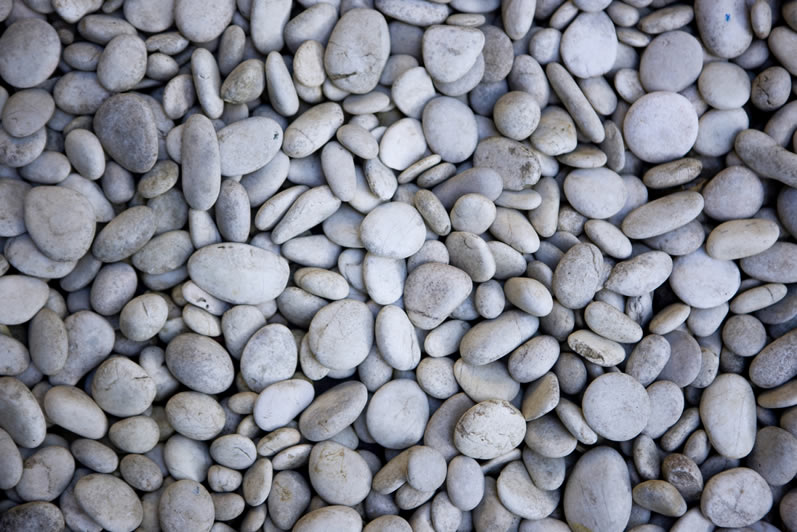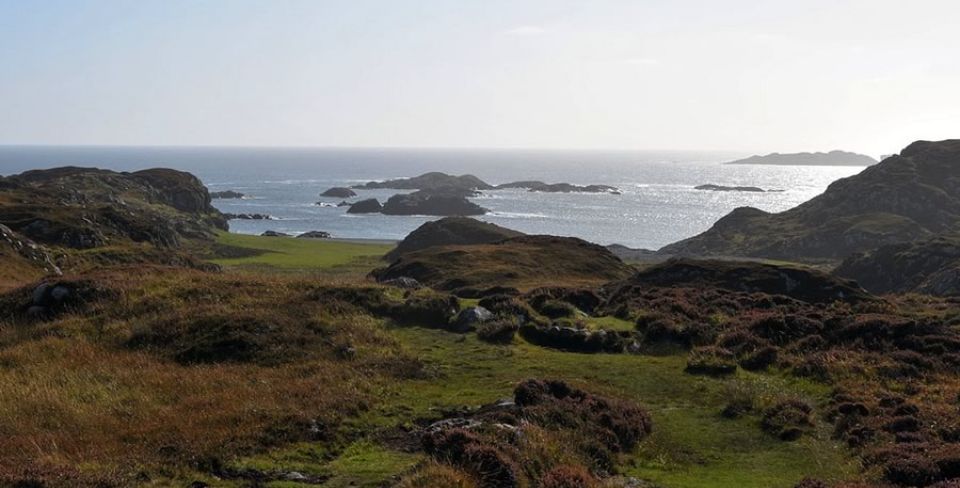7.7 St Columba’s Bay
Colmcille arrived in Iona from Argyll in 563 where he had been seeking permission to build a monastery on land belonging to the ruling clan – the Dál Riata.
From the Argyll coast, he would have presumably sailed along the south coast of Mull and landed on the south of Iona at the place now populalry called St Columba’s Bay.
There are two pebbly beaches here – Port a’ Churaich – or Harbour of the Coracle (a boat made of hide) – and Port an Fhir-bhrèige – separated by a spur of rock. Colmcille is said to have landed at Port a’ Churaich.
There is a story that when Colmcille left Ireland, he vowed to set up a monastery in a place from where he could not see his home country. According to tradition, when they arrived in Iona, Colmcille and his 12 companions who had set sail from Derry climbed the hill to the west of Port na Curaich to ensure that the saint could fulfill his promise. The hill is called ‘The Hill of the Back to Ireland’. Colmcille is recorded as returning to Ireland at least once – to attend the convention at Drum Ceat – just outside modern-day Limavady.
Historic accounts of this bay tell how there were two heaps of stones on the beach which represented the length of Colmcille’s boat. An early 18th century account reports this distance as ‘three score of foots’ or 60 feet/18.3 metres.
In 1963, a group of 13 men sailed from Derry to Iona in a boat similar to those used in Colmcille’s time, making the journey in 8 days and camping each night.
The pebbles from the beach at St Columba’s Bay have often been collected by pilgrims. The white limestone pebbles found in the southeast of the island are known as Iona Marble. In the 18th and 19th centuries tourists bought them from local children as a souvenir.

Some pilgrims visiting the island today pick up two stones from the beach. One is thrown back into the sea as a symbol of something in their life that they would like to leave behind. The other is taken home as a sign of a new commitment they have made.
Up behind Port an Fhir-bhreige there are about 50 cairns varying in size. There are various ideas about their origins – that they are burial cairns, which is unlikely; that they were built by monks as a penance; or that they were created as medieval pilgrims visited the site.
Iona
- 7.1 The High Crosses and the Abbey
Colmcille arrived on Iona in 563 having left Derry in Ireland. According to tradition, Colmcille looked for a place to build his monastery where he would not be able to see his homeland - hence his choice of Iona. He also needed to find a place where he could live and work...
- 7.2 Abbey, Cloister and Vallum
The Vallum marked the boundary of the Colmcille’s monastery on Iona. It is formed by two embankments on either side of a deep ditch. This raised ground is 335 metres long by 152 metres wide. ‘Vallum’ comes from the Latin word for the fortifications of a camp but this was...
- 7.3 St Oran’s Chapel and Graveyard
A cobbled track runs between St Martin's Cross and the wall of the graveyard. This is the only visible portion of 'The Street of the Dead', a medieval pilgrimage route used for funeral processions. St Oran’s Chapel is the oldest ecclesiastical building on Iona, and dates from the 12th century....
- 7.4 The Nunnery/An Eaglais Dhubh
The Nunnery was built at about the same time as the Benedictine Abbey - in the 13th century - by Reginald, son of Somerled, Lord of the Isles. His sister Bethoc was the first prioress. Bethoc followed the Rule of St Augustine. Iona had one of only two Augustinian nunneries...
- 7.5 Martyr’s Bay
Martyrs Bay is just south of the village and pier. The derivation of its name is not certain. If the original name was Port nam Mairtear, it may allude to the slaughter of monks in one of the Norse raids of the 9th century. Or the word ‘mairtear’ may be...
- 7.6 Hill of the Angels
The centre of the island is fertile grazing ground called The Machair - machair meaning a plain or level field. Continue walking south, with the Sound of Iona on your left. The road turns right to lead west across the island. On the left, just before the gate onto the...
- 7.7 St Columba’s Bay
Colmcille arrived in Iona from Argyll in 563 where he had been seeking permission to build a monastery on land belonging to the ruling clan - the Dál Riata. From the Argyll coast, he would have presumably sailed along the south coast of Mull and landed on the south of Iona at...
- 7.8 The Hermit’s Cell
Today all that remains of the Hermit’s Cell is a rough stone foundation of an oval hut which would have been made of timber or turf. An entrance faces southwest to capture the most daylight. As he tells stories from Colmcille’s life, the saint’s biographer Adomnán describes the island...










Bòrd na Gàidhlig
Great Glen House
Leachkin Road
Inverness
Scotland, IV3 8NW
(+44) 01463 225454
colmcille@gaidhlig.scot
Colmcille
Foras na Gaeilge, 2-6 Queen Street
Belfast
Northern Ireland
BT1 6ED
(+44) 028 9089 0970
colmcille@forasnagaeilge.ie
Colmcille
Foras na Gaeilge, An Chrannóg
Na Doirí Beaga
Gaoth Dobhair
Donegal, Ireland. F92 EYT3
(+353) 074 9560113
colmcille@forasnagaeilge.ie


